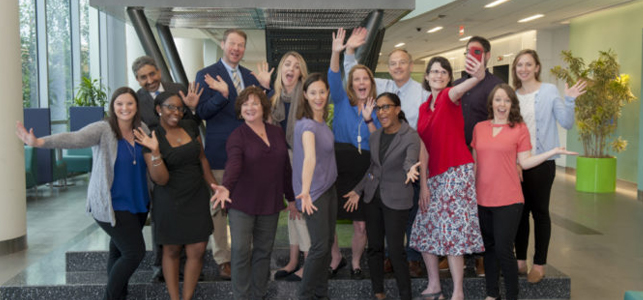
When a baby is born with a cleft lip and/or palate or another craniofacial condition, parents are faced with important decisions about surgery, recovery and ongoing care.
Our Center for Craniofacial Care helps families through every step of the surgery and recovery process. The team is led by Dr. Jennifer Rhodes, the only full-time craniofacial and pediatric plastic surgeon in Virginia. She works hand-in-hand with Ruth Trivelpiece, speech therapist and program coordinator, to ensure that each child’s unique surgical, speech, visual, dental, developmental and psychosocial needs are met with excellent and coordinated care as long as needed, from infancy through young adulthood. The team also plans periodic special events for patients at the center so they can meet each other and have some fun along the way.
The interdisciplinary craniofacial team includes experts from plastic surgery, neurosurgery, ophthalmology, otolaryngology (ENT), oral/maxillofacial surgery, dental, orthodontics, genetics, sleep medicine, audiology, psychology, speech therapy, care coordination and nursing.
In recognition of National Cleft & Craniofacial Awareness Month, we join organizations from across the country in increasing understanding and raising awareness about clefts and craniosynostosis, another common craniofacial condition.
Did you know? Facts about clefts
- Cleft lip and/or palate are among the most common birth defects in the United States. One in 700 children, or about 7,000 babies are born each year with a cleft.
- An orofacial cleft is an opening in the lip gum, or roof of the mouth (palate).
- Clefts occur during the first trimester of pregnancy, often before a woman knows she is pregnant.
- Clefts are usually repaired with surgery in the first year of life, though many children will need more surgeries and treatments throughout their adolescence and adult life.
- Children born with clefts may have problems with feeding, speech, self-esteem, hearing and teeth.
- There is no single factor related to the cause of clefts. Sometimes clefts run in families or may be associated with environmental factors or other problems. In about two-thirds of children, there is no known cause.
- Individuals born with clefts lead fulfilling, successful and accomplished lives.
Did you know? Facts about craniosynostosis
- One in 2,500 children is born each year with craniosynostosis.
- Craniosynostosis usually occurs during pregnancy when the joints (sutures) between the bones of the baby’s skull join together and close too early.
- Early closure of the sutures will not allow the skull to expand to adjust to the growth of the baby’s brain, increasing pressure in the skull and leading to an abnormal head shape.
- There are four sutures in the skull: sagittal, metopic, coronal and lambdoid.
- Most craniosynostoses are isolated or non-syndromic and involve only one suture.
- Some craniosynostoses are syndromic and involve two or more sutures. Babies may have other birth defects and developmental delays.
- The exact cause of craniosynostosis is not yet clear but may be a combination of genes, environmental factors or the presence of certain syndromes.
- Surgery is done usually in the first year of life if there is a risk for increased pressure on the brain and the skull shape is abnormal.
- Most children with single suture craniosynostosis have normal development and good results after surgery.
